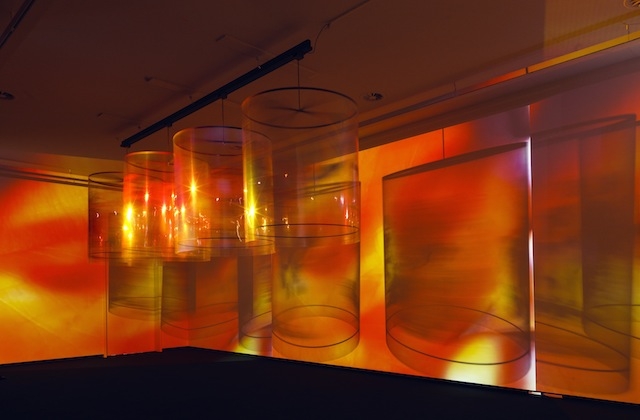In 1951 the Dutch artist Karel Appel was commissioned to make a three-dimensional painting in the Stedelijk Museum’s former restaurant, which, since the renovation of the museum in 2014, functions as an extra gallery space. He covered the walls and ceiling with a lively scene of a blooming garden, replete with colourful animals and playing children, and executed it in his characteristic CoBrA style. There is not much left of that postwar optimism and exuberance in Migration (1991–2017), the response Nalini Malani has formulated to Appel’s work as an introduction to her solo show at the Stedelijk. Her palette, in contrast to that of the Dutchman, is sombre, reduced to black charcoal. No joyful scenes here, but a constellation of gloomy elements – including an army helicopter, two dreary faces staring at the spectator and a kneeling man holding a broken globe – interconnected through a series of lines. What Malani presents us with is not only an intro, but a foreboding of a dystopian new world order.
Rising nationalism, tensions between India and Pakistan, globalisation and migration, the oppression of women – all these ‘local’ themes are elevated to an allegorical and more universal level
The doom and gloom, however, is of a temporary nature, as the mural will be erased during a so-called erasure performance at the end of the exhibition, a practice the artist has applied on other occasions during her five-decade career. Such is the case with City of Desires (1992), Malani’s first site-specific wall-drawing installation, which was on view for only 15 days in Mumbai’s Chemould Gallery and is brought back to life here via a video recording of the performance. Through a variety of chalk drawings, she refers, among other things, to the growing influence of rightwing Hindu nationalists, a recurring preoccupation in her work that has – unfortunately – become even more urgent since current Indian Prime Minister Narendra Modi took power in 2014.
Rising nationalism, tensions between India and Pakistan, globalisation and migration, the oppression of women – all these ‘local’ themes are elevated to an allegorical and more universal level, and tackled in a visually abundant style, for which Malani picks a variety of media to suit her message and also often reintroduces and reworks elements from earlier pieces. In Search of Vanished Blood (2012) is a six-channel video/ shadow play she produced for Documenta 13, presented here as a single-channel video. In this version – which combines video, animation, text and sound in a manner both emotional and experimental – Malani uses, as she often does, a strong female character from Greek mythology, in this case Cassandra, to give voice to the voiceless, a gang-raped Indian woman.
A series of blood-red prints, in which one can recognise chopped-up body parts, expresses the violence that is suggested in In Search of Vanished Blood, while the work also recurs in book format – a medium Malani introduced out of a desire to elaborate her subject beyond a single print – presented alongside others in a vitrine. The print series I am the Angel of Despair (2015) is equally based on the video, but in a more literal way, by extracting film. Film stills extracted from the video are superimposed with war iconography – a skull, fleeing women – painted in watercolour.
The combination of different media, resulting in new, hybrid genres, reaches its culmination in Transgressions (2001), part of the Stedelijk’s permanent collection and the magnum opus around which the entire exhibition is built up. This ‘video/shadow play’ is an immersive environment comprising four transparent, rotating cylinders, painted from the inside in the Kalighat style, which was considered the first modern style used to comment on contemporary issues. The cylinders depict various scenes, such as two figures (representing India and Pakistan) boxing, the goddess Kali holding the decapitated heads of English colonisers in its many arms, and a Western hunter on an elephant. Their cast shadows create a hypnotising play across the gallery walls, which are bathed in various hues, accompanied by ambient soundscapes and superimposed video projections. In a true postcolonial spirit, century-old legends and contemporary, Western-style consumer references about golf courses and mobile phone operators come together in a unique mix. This is Malani at her best, and the exhibition as a whole, despite its modest size, functions as a convincing overview of her practice.
First published in the Summer 2017 issue of ArtReview Asia
